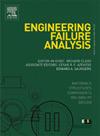采用不同排气技术分析内部爆燃下的燃料储存罐:实验和数值研究
IF 4.4
2区 工程技术
Q1 ENGINEERING, MECHANICAL
引用次数: 0
摘要
本研究调查了受到甲烷-空气内部爆炸影响的小型燃料储存罐,重点研究了利用顶盖通风减轻超压和损坏的三种减压技术。在甲烷-空气浓度较低的情况下进行了测试,以产生假静态内部压力。这种方法最大限度地减少了规模效应,并使内部压力频率与爆燃时实际规模的罐体行为保持一致。第一个原型的特点是,罐顶与罐壳交界处的缝合焊缝局部脆性失效,从而激活了易碎罐顶。这证实了缝合焊缝模式可确保受控脆性破坏,并通过简化方程估算激活压力。第二种技术采用顺序通风策略,首先是小铰链板,然后是缝合焊缝破坏,仅用小通风口就能控制中低强度的爆炸,并能快速恢复运行。在严重爆炸中,铰链门有助于更早启动易碎顶盖,降低初始压力上升率并控制顶盖打开方向。最后,该研究探讨了装有商用防爆通风板的储罐,作为传统易碎顶盖的替代方案,为现有储罐的改造提供了实用的解决方案。每种技术都能在爆炸事件中有效管理内部压力,从而提高燃料储存设施的安全性。本文章由计算机程序翻译,如有差异,请以英文原文为准。
Analysis of fuel storage tanks under internal deflagrations with different venting technologies: an experimental and numerical study
This study investigates small-scale fuel storage tanks subjected to internal methane-air explosions, focusing on three depressurization technologies using roof ventilation to mitigate overpressure and damage. Tests with low methane-air concentrations were conducted to generate a pseudo-static internal pressure. This approach minimized scale effects and aligned internal pressure frequency with real-scale tank behavior during deflagrations. The first prototype features a tank with a frangible roof activated by localized brittle failure of stitch welds around the roof-to-shell junction. This confirms that stitched weld patterns ensure controlled brittle failure with activation pressure estimated by a simplified equation. The second technology employs a sequential ventilation strategy, starting with a small hinged panel followed by stitch weld failure, managing low to medium-intensity explosions with the small vent alone, and allowing rapid operational recovery. In severe explosions, the hinged door facilitates earlier activation of the frangible roof, reducing the initial pressure rise rate and controlling the roof opening direction. Lastly, the study explores tanks with commercial explosion vent panels as an alternative to traditional frangible roofs, offering a practical solution for retrofitting existing tanks. Each technology enhances safety in fuel storage facilities by effectively managing internal pressures during explosive events.
求助全文
通过发布文献求助,成功后即可免费获取论文全文。
去求助
来源期刊

Engineering Failure Analysis
工程技术-材料科学:表征与测试
CiteScore
7.70
自引率
20.00%
发文量
956
审稿时长
47 days
期刊介绍:
Engineering Failure Analysis publishes research papers describing the analysis of engineering failures and related studies.
Papers relating to the structure, properties and behaviour of engineering materials are encouraged, particularly those which also involve the detailed application of materials parameters to problems in engineering structures, components and design. In addition to the area of materials engineering, the interacting fields of mechanical, manufacturing, aeronautical, civil, chemical, corrosion and design engineering are considered relevant. Activity should be directed at analysing engineering failures and carrying out research to help reduce the incidences of failures and to extend the operating horizons of engineering materials.
Emphasis is placed on the mechanical properties of materials and their behaviour when influenced by structure, process and environment. Metallic, polymeric, ceramic and natural materials are all included and the application of these materials to real engineering situations should be emphasised. The use of a case-study based approach is also encouraged.
Engineering Failure Analysis provides essential reference material and critical feedback into the design process thereby contributing to the prevention of engineering failures in the future. All submissions will be subject to peer review from leading experts in the field.
 求助内容:
求助内容: 应助结果提醒方式:
应助结果提醒方式:


